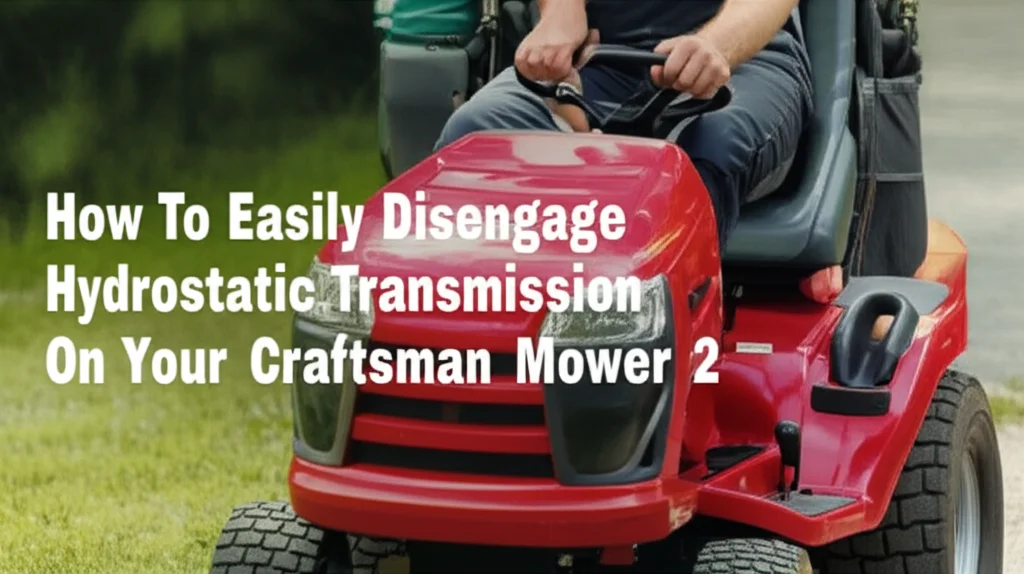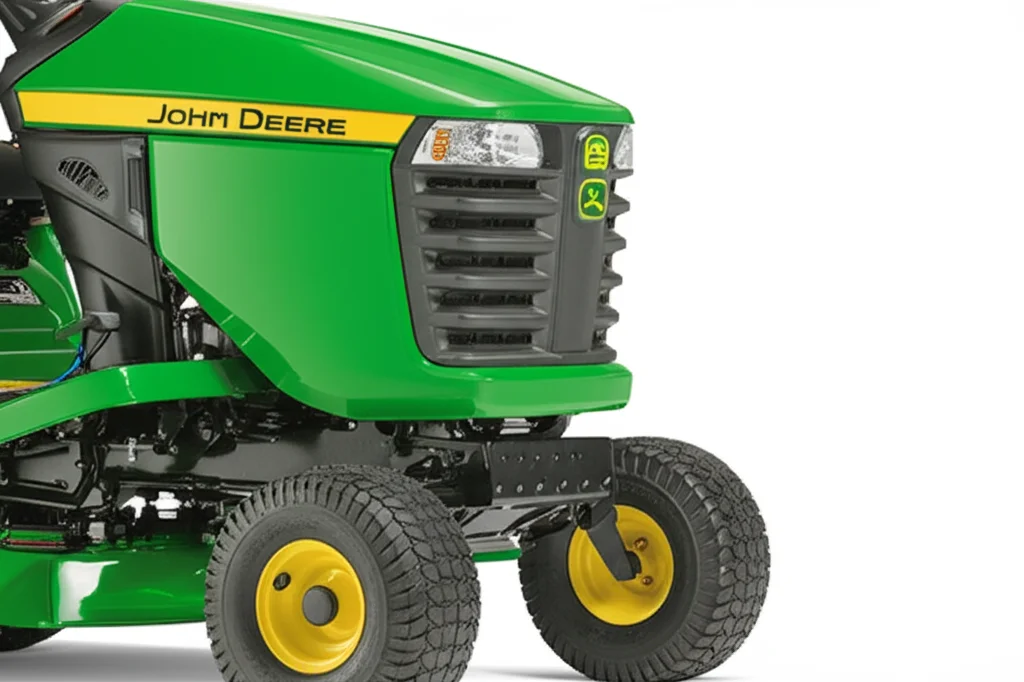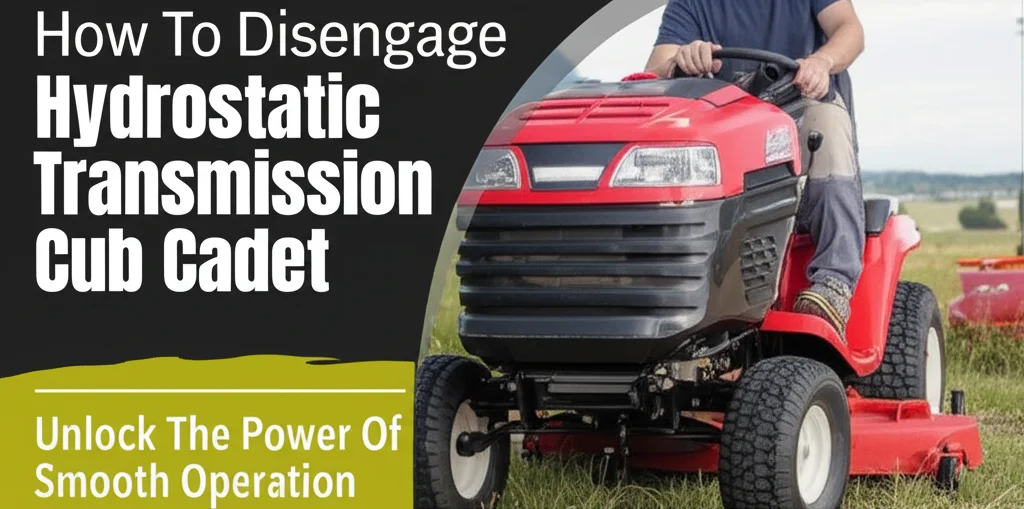· Lawn Mower Maintenance · 6 min read
How To Easily Disengage Hydrostatic Transmission On Your Craftsman Mower 2

Easily Disengage Your Craftsman Mower’s Hydrostatic Transmission
Have you ever needed to move your Craftsman riding mower for storage or maintenance, only to find it stubbornly refusing to roll freely? This is likely because the hydrostatic transmission is engaged. Disengaging it allows the wheels to turn freely, making maneuvering much easier. This guide will walk you through the process, ensuring you can safely and efficiently disengage the hydrostatic transmission on your Craftsman mower. We’ll cover everything from locating the disengagement lever to understanding why it’s important for proper mower care.
Takeaway:
- Disengaging the hydrostatic transmission allows for free wheel movement.
- It’s crucial for safe transport and maintenance.
- The process is usually simple, involving a specific lever or bypass plug.
- Always consult your owner’s manual for model-specific instructions.
What does it mean to disengage the hydrostatic transmission?
Disengaging the hydrostatic transmission on your Craftsman mower essentially disconnects the engine power from the wheels. This allows you to push or tow the mower without damaging the transmission. It’s a simple process, usually involving a lever or plug, and is essential for maintenance and transport.
Understanding Your Craftsman Hydrostatic Transmission
Before diving into the “how-to,” let’s quickly understand what a hydrostatic transmission does. It uses hydraulic fluid to transfer power from the engine to the wheels, providing smooth and variable speed control. When engaged, this system locks the wheels to the engine, allowing for powered movement. However, for tasks like washing your mower, you’ll want to free the wheels. Keeping your mower clean is important, so consider how to clean a lawn mower after disengaging the transmission. Understanding this system helps you appreciate why disengagement is necessary for certain procedures. Different Craftsman mower models may have slightly different transmission setups, so always refer to your owner’s manual.
Locating the Hydrostatic Transmission Disengage Lever
The most common method for disengaging the hydrostatic transmission involves a lever. This lever is typically located under the mower’s seat, near the rear of the machine. It’s often brightly colored – usually red or yellow – for easy identification. Sometimes, it might be labeled “Transmission Bypass” or something similar. Take a moment to familiarize yourself with the location of this lever on your specific Craftsman mower model. If you’re having trouble locating it, your owner’s manual will have a diagram.
Disengaging the Transmission: Step-by-Step Guide
Now, let’s get to the actual disengagement process. Here’s a step-by-step guide:
- Park on a Level Surface: Ensure your mower is parked on a flat, level surface. This prevents unexpected rolling.
- Turn Off the Engine: Completely shut off the engine and remove the key. Safety first!
- Locate the Disengage Lever: Find the lever we discussed earlier, usually under the seat.
- Move the Lever: Push or pull the lever into the disengage position. You should feel a distinct click or movement. The lever will typically have a clear indication of the engaged and disengaged positions.
- Test the Wheels: Try to roll the mower forward or backward. The wheels should now turn freely. If they don’t, double-check the lever position and consult your owner’s manual.
Alternative Disengagement Methods: Bypass Plugs
Some older Craftsman mower models, or those with specific transmission types, may utilize a bypass plug instead of a lever. This plug, usually located near the hydrostatic transmission unit, needs to be removed to disengage the system. Removing this plug releases the hydraulic pressure, allowing the wheels to rotate freely. Be cautious when removing the plug, as a small amount of hydraulic fluid may escape. It’s a good idea to have some rags handy. If you’re dealing with spilled fluid, you might want to check out how to clean automatic transmission fluid off of concrete.
Understanding Bypass Plug Safety
When working with a bypass plug, always wear safety glasses to protect your eyes from potential fluid splashes. Also, ensure the engine is completely off and cool before attempting to remove the plug. Properly dispose of any spilled hydraulic fluid according to local regulations.
Why Disengaging is Important: Maintenance and Transport
Disengaging the hydrostatic transmission isn’t just about making the mower easier to move. It’s crucial for several maintenance tasks. For example, when cleaning the underside of the mower deck, you need to be able to roll the mower freely. Similarly, when performing blade sharpening or other repairs, disengagement prevents accidental movement. When transporting your mower on a trailer, disengaging the transmission is essential for safe loading and unloading. Don’t forget to also how to clean the mower carb for optimal performance.
Re-Engaging the Transmission: Getting Back to Work
Once you’ve completed your maintenance or transport, re-engaging the transmission is just as simple as disengaging it.
- Locate the Lever/Plug: Find the disengage lever or bypass plug.
- Return to Engage Position: Move the lever back to its original position, or reinstall the bypass plug securely.
- Test the Drive: Start the engine and slowly test the drive system to ensure it’s functioning correctly.
Frequently Asked Questions (FAQ)
Q: My disengage lever is stuck. What should I do?
A: First, try applying some penetrating oil to the lever’s pivot point. If that doesn’t work, consult your owner’s manual or a qualified mechanic. Forcing the lever could cause damage.
Q: Can I drive my mower a short distance with the transmission disengaged?
A: No, absolutely not. The mower will have no braking ability and could roll out of control. Always re-engage the transmission before operating the mower.
Q: What if I can’t find a disengage lever or bypass plug on my mower?
A: Consult your owner’s manual. Some newer models may have a different disengagement system. If you still can’t find it, contact Craftsman customer support.
Q: Is it normal for a small amount of fluid to leak when removing the bypass plug?
A: Yes, a small amount of leakage is normal. Have rags handy to clean up any spills.
Conclusion
Disengaging the hydrostatic transmission on your Craftsman mower is a straightforward process that’s vital for safe maintenance and transport. By following the steps outlined in this guide, you can easily unlock the wheels and make your mower more manageable. Remember to always consult your owner’s manual for model-specific instructions and prioritize safety. Keeping your mower in good working order, including knowing how to clean air filter on lawn mower, will ensure years of reliable service. Now you’re equipped to handle this essential mower maintenance task with confidence!
- hydrostatic transmission
- Craftsman mower
- mower maintenance
- riding mower
- disengage transmission



